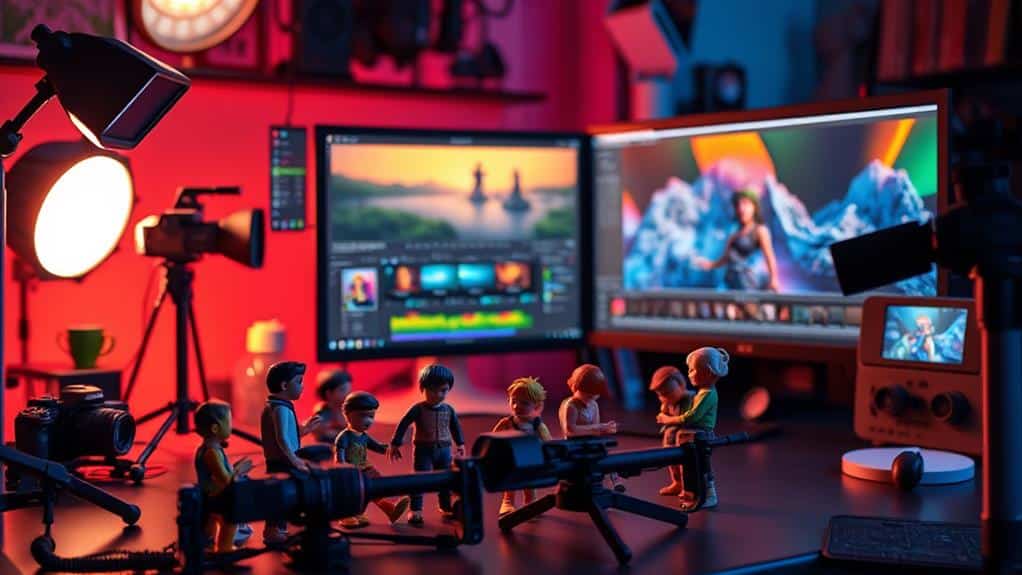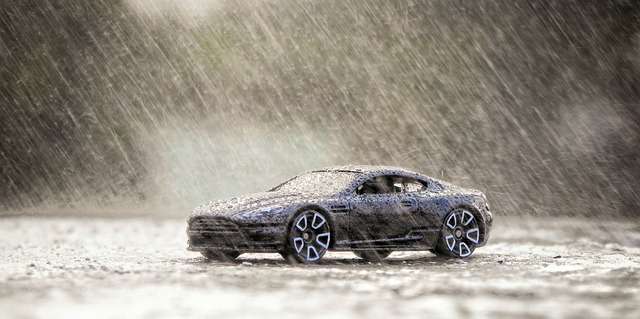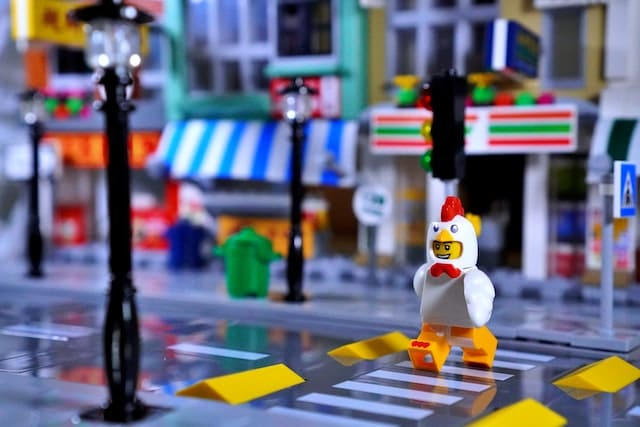To master advanced high-speed photography for toy figurines, start with a DSLR or mirrorless camera that offers high frame rates and fast shutter speeds. Stabilize your setup with a sturdy tripod and use a remote shutter release to minimize vibrations. Good lighting is essential, so position LED panels and softboxes strategically to avoid harsh shadows and glare. Opt for simple or neutral backgrounds and apply the rule of thirds for engaging composition. Capture motion with burst modes and a shallow depth of field to emphasize the figurine. Post-process with tools like Lightroom to enhance and perfect your images further. Explore more techniques to bring your figurines to life.
Equipment Essentials
To immerse yourself in high-speed photography, you'll need a few fundamental pieces of equipment to capture those fleeting moments with precision. Start with a camera capable of high frame rates; something like a DSLR or mirrorless camera with manual settings is ideal. Look for models that offer quick shutter speeds, around 1/1000th of a second or faster, to freeze action effectively. Pair it with a lens that suits your subject size and desired depth of field, like a 50mm prime lens for crisp detail on toy figurines.
Next, invest in a sturdy tripod. It stabilizes your camera, guaranteeing sharp images despite quick movements. A remote shutter release is also vital, allowing you to trigger the camera without causing any vibrations. This guarantees your shots remain steady, even during burst modes.
You'll benefit from a high-speed memory card, too. Look for cards with fast write speeds to handle the rapid succession of images. This prevents buffering issues that could disrupt your shooting flow. Finally, consider a backdrop to isolate your subject, reducing distractions and enhancing focus. With these tools, you're well-equipped to plunge into the fascinating world of high-speed photography.
Lighting Optimization
How can you capture those split-second moments without the right lighting? You can't. Lighting plays a significant role in high-speed photography, especially when working with toy figurines. To get started, think about the light's direction, intensity, and color temperature. Using diffused light helps to soften shadows and create an even distribution, which is vital for capturing intricate details on small subjects.
Consider using a combination of LED panels, softboxes, and reflectors to control your lighting environment. LEDs provide consistent and adjustable lighting, allowing you to experiment with different settings until you find what works best. It's important to position your lights strategically to avoid unwanted glare or harsh shadows, particularly with reflective surfaces on toys. You can also use colored gels or diffusers to add creative effects or soften the light for a more polished look. Reflectors are especially useful to bounce light and fill in shadows, ensuring an even exposure. To enhance toy photography with reflections, consider incorporating glossy surfaces or mirrors strategically beneath your toys to create dynamic compositions and add depth to your shots.
Here's a basic lighting setup you might find useful:
| Light Source | Position | Purpose |
|---|---|---|
| LED Panel | Front-left | Main light source |
| Softbox | Front-right | Fill light to soften shadows |
| Reflector | Below the figurine | Bounce light and reduce shadows |
Background and Composition

While lighting sets the stage for high-speed photography, the background and composition complete the visual narrative. When photographing toy figurines, you need to carefully consider the backdrop, as it influences your image's mood and focus. Choose a background that complements the figurine, guaranteeing it doesn't distract from the subject. Neutral colors often work best, as they allow the figurine's details to pop. Alternatively, a simple gradient or a textured surface can add depth without overpowering the scene.
Pay attention to composition, which guides your viewer's eye through the photograph. Employ the rule of thirds by placing key elements along imaginary grid lines that divide your frame into nine equal parts. This technique creates a balanced and engaging image. Consider the use of leading lines, which naturally draw attention to the figurine, enhancing the overall impact.
Depth of field also plays a significant role in composition. A shallow depth of field can isolate the figurine from the background, adding emphasis and creating a professional look. Use props sparingly to enhance storytelling, but make certain they don't overshadow the main subject. With thoughtful planning, your composition will elevate your high-speed photography to new heights.
Capturing Motion Effects
When you're diving into high-speed photography, capturing motion effects can transform a simple image into a dynamic masterpiece. The key to success lies in your ability to freeze action and convey movement simultaneously. Start by selecting your toy figurine and deciding which part of its action-packed narrative you want to capture. Do you want to show a superhero mid-flight, or a car skidding around a corner? Your choice will guide your setup and camera settings.
To effectively capture motion effects, consider these essential tips:
- Shutter Speed: Use a fast shutter speed to freeze motion, around 1/1000s or faster, to capture every detail.
- Lighting: Guarantee you have ample lighting. Use flashes or continuous lights to illuminate your scene without causing blur.
- Stabilization: Use a tripod to keep your camera steady, eliminating unintentional movement in your shots.
- Anticipation: Predict the peak action moment, so you're ready to capture it.
- Burst Mode: Shoot in burst mode to increase your chances of capturing the perfect moment.
Post-Processing Techniques

In high-speed photography, post-processing is your chance to elevate your images from impressive to extraordinary. This is where the magic happens, and you can transform your toy figurine photos into enchanting works of art. Start by using software like Adobe Photoshop or Lightroom for basic adjustments—crop, exposure, contrast, and color correction. These changes help highlight the dynamic motion you captured.
Consider using layers and masks to enhance or remove specific areas. Applying selective sharpening can make your figurine pop against a blurred background. Don't hesitate to experiment with filters or presets to add mood and style to your shots.
Here's a quick table to remember key tools and their purposes:
| Tool | Purpose |
|---|---|
| Crop Tool | Refine composition |
| Exposure Adjustment | Correct lighting issues |
| Layers and Masks | Isolate and edit specific areas |
| Selective Sharpening | Enhance details |
| Presets and Filters | Add style and mood |
Frequently Asked Questions
How Can I Prevent Dust From Settling on My Toy Figurines During a Shoot?
Keep your workspace clean by regularly dusting surfaces. Use a soft brush to gently remove dust from figurines before shooting. Consider using a dust blower or air purifier to minimize airborne particles during your photography session.
What Are the Best Practices for Storing Toy Figurines to Maintain Their Condition?
Did you know 80% of damage to collectibles happens during improper storage? Keep your figurines in a dust-free, cool environment. Use acid-free boxes or display cases to protect from light and moisture, ensuring longevity and pristine condition.
How Do I Choose the Right Scale for Toy Figurines in My Photography?
To choose the right scale for your toy figurine photography, consider your composition goals. Match the scale with your scene's elements for realism. Experiment with different sizes to see what enhances your story and visual impact best.
Can Weather Conditions Affect the Outcome of Outdoor Figurine Photography?
Did you know 75% of outdoor photos are affected by weather? Yes, weather conditions can impact your figurine photography. Wind disrupts stability, while rain and humidity can damage equipment or alter lighting, creating unexpected challenges and opportunities.
What Are Some Creative Ways to Display My Toy Photography Portfolio?
You can showcase your toy photography portfolio by creating a vibrant website, designing an interactive digital flipbook, printing a sleek photo book, or curating an engaging social media account to captivate and inspire your audience.
At a Glance
So there you have it, aspiring toy figurine photographers! With your arsenal of equipment, lighting expertise, and an eye for composition, you're practically ready to shoot the next blockbuster toy movie. Who knew capturing plastic warriors in action could be this thrilling? And let's not forget the dramatic post-processing, where you can transform your figurines into cinematic legends. Remember, this isn't just photography; it's a miniature world of epic storytelling. Happy snapping, Spielberg of toys!





